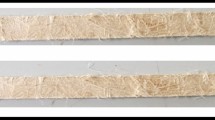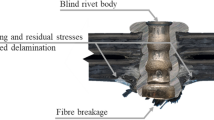Abstract
Mechanical performance of commercially manufactured unsized and γ-aminopropylsilane sized boron-free E-glass fibres has been characterised using single-fibre tensile test. Both apparent fibre modulus and fibre strength were found to strongly depend on fibre gauge length. The average strength of sized fibres was found 40–80 % higher than unsized fibres at different gauge lengths. Weibull analysis suggested that the failure mode of unsized fibres could be described by unimodal Weibull distribution, whereas the strength distribution of sized fibres appeared to be controlled by two exclusive types of flaw population, types A and B. Comparison of the Weibull plots between unsized and sized fibres revealed that the strength of unsized fibres was likely to be dominated by type A flaws existing on the bare glass surface and type B flaws may be related to the defects on the glass surface coated with silane. This was partially supported by the observation of fractured cross-sectional area using SEM. It was, therefore, proposed that the strength difference between unsized and sized glass fibres may be more reasonably interpreted from the surface protection standpoint as opposed to the flaw healing effect. The results obtained from this study showed that silane coupling agent plays a critical role in the strength retention of commercially manufactured E-glass fibres and the silane effect on the fibre strength is also affected by the change in gauge length of the sample.






Similar content being viewed by others
References
Kolesov YI, Kudryavtsev MY, Mikhailenko NY (2001) Glass Ceram 58(5):197. doi:10.1023/a:1012386814248
Wallenberger FT, Watson JC, Li H (2001) Glass fibres, vol 21. ASM handbook. ASM International, Material Park
Lowenstein KL (1993) The manufacturing technology of continuous glass fibres. Elsevier, Amsterdam
Bartenev GM, Sidorov AB (1965) Glass Ceram 22(9):597
Otto WH (1955) J Am Ceram Soc 38(3):122. doi:10.1111/j.1151-2916.1955.tb14588.x
Schmitz GK, Metcalfe AG (1966) Ind Eng Chem Prod Res Dev 5(1):1. doi:10.1021/i360017a001
Gupta PK (2002) In: Elices M, Llorca J (eds) Fiber fracture. Elsevier Science Ltd, Oxford, p 127
Thomason JL, Kalinka G (2001) Composites A 32(1):85. doi:10.1016/s1359-835x(00)00122-6
Thomason JL, Adzima LJ (2001) Composites A 32(3–4):313. doi:10.1016/s1359-835x(00)00124-x
Reilly SP, Thomason JL (2010) In: Paper presented at the 14th European conference on composite materials, ECCM14, Budapest, Hungary
Zinck P, Pay MF, Rezakhanlou R, Gerard JF (1999) J Mater Sci 34(9):2121. doi:10.1023/A:1004572112470
Zinck P, Mäder E, Gerard JF (2001) J Mater Sci 36(21):5245. doi:10.1023/A:1012410315601
Otto WH (1961) J Am Ceram Soc 44(2):68. doi:10.1111/j.1151-2916.1961.tb15352.x
Sakka S (1957) Bull Inst Chem Res Kyoto Univ 34(6):316
Feih S, Boiocchi E, Mathys G, Mathys Z, Gibson AG, Mouritz AP (2011) Composites B 42(3):350. doi:10.1016/j.compositesb.2010.12.020
Feih S, Thraner A, Lilholt H (2005) J Mater Sci 40(7):1615. doi:10.1007/s10853-005-0661-4
Thomason JL (2007) Polym Compos 28(3):331. doi:10.1002/pc.20260
Thomason JL (1999) Compos Sci Technol 59(16):2315. doi:10.1016/s0266-3538(99)00083-4
Thomason JL (1995) Composites 26(7):477. doi:10.1016/0010-4361(95)96805-g
Metcalfe AG, Schmitz GK (1964) Proc ASTM 64:1075
Schmitz GK, Metcalfe AG (1965) In: 20th Anniversary technical conference, 1965. The Society of the Plastics Industry, Washington, DC
Weibull W (1939) A statistical theory of the strength of materials. Handlingar, Royal Swedish Academy of Engineering Sciences 151
Weibull W (1951) J Appl Mech 18:293
Thomason JL (2012) Compos Sci Technol (Submitted)
Andersons J, Joffe R, Hojo M, Ochiai S (2002) Compos Sci Technol 62(1):131. doi:10.1016/s0266-3538(01)00182-8
Beetz CP Jr (1982) Fibre Sci Technol 16(1):45. doi:10.1016/0015-0568(82)90015-x
Beetz CP (1982) Fibre Sci Technol 16(2):81. doi:10.1016/0015-0568(82)90027-6
Zinck P, Gérard JF, Wagner HD (2002) Eng Fract Mech 69(9):1049. doi:10.1016/s0013-7944(01)00121-7
Zinck P, Pays MF, Rezakhanlou R, Gerard JF (1999) Philos Mag A 79(9):2103
Acknowledgements
The authors gratefully acknowledge the funding from Engineering and Physical Sciences Research Council (EPSRC) through the project under the title of Towards Affordable, Closed-Loop Recyclable Future Low Carbon Vehicle Structures (TARF-LCV). The authors would also like to thank Owens Corning Vetrotex for providing the glass fibres used in this study. Special thanks are given to Advanced Materials Research Laboratory (AMRL) in the University of Strathclyde for the use of SEM. Finally, the authors would like to express their gratitude to the reviewer for the valuable advice on the improvement of this manuscript as well as suggestions for possible further work.
Author information
Authors and Affiliations
Corresponding author
Rights and permissions
About this article
Cite this article
Yang, L., Thomason, J.L. Effect of silane coupling agent on mechanical performance of glass fibre. J Mater Sci 48, 1947–1954 (2013). https://doi.org/10.1007/s10853-012-6960-7
Received:
Accepted:
Published:
Issue Date:
DOI: https://doi.org/10.1007/s10853-012-6960-7




